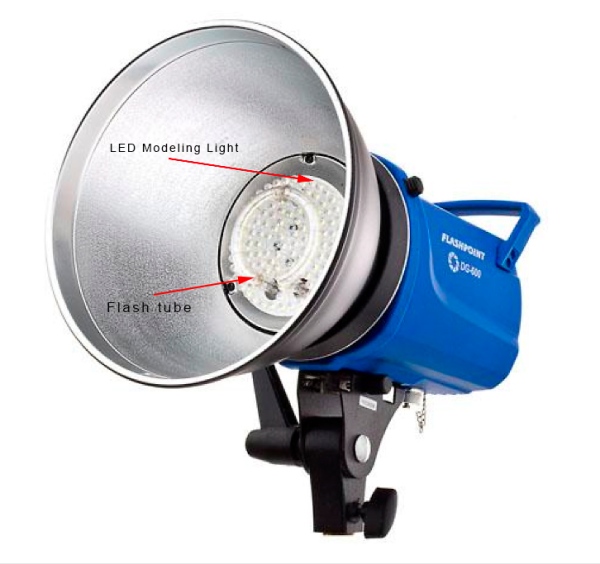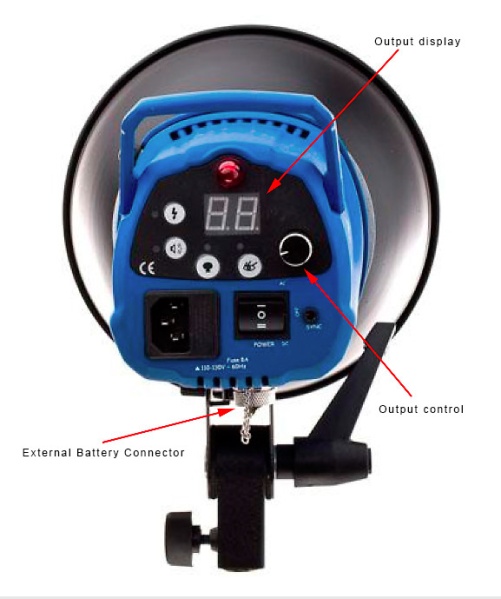I’ve been testing a studio strobe from Adorama, the Flashpoint DG-600. Intended for use in both studio and location work, this is a 300/WS workhorse (published guide number of 58m/190ft ISO 100) that offers flexibility in many types of shooting situations. It can run on normal household power (US) or a 12v DC power pack.
The housing of the light is made of heavyweight plastic, and seems quite durable. An attached carrying handle is provided, as is a 8” metal reflector – the latter is attached using a locking bayonet-style design.
On the front end, one sees a conventional semi-circular flash tube mounted in front of an LED-array modeling light.
At the back, most controls are push-button variety, with the exception of the power switch, which provides on/AC, off, and on/DC positions.
The unit is provided with a nice long power cord (which is a good change – it seems lately that power cords are shrinking in length, or are not provided at all), and a PC/sync cord for those of use who haven’t yet gone to wireless triggers. The sync plug on the housing is of mini-plug variety, not the full-size “stereo” plugs one often sees.
Push button controls include flash test, sound on/off, modeling light, and slave operation. Flash intensity is read through a digital numeric display, and is controlled through a rotating knob. Flash intensity numbers are not linked to f/stop, but are displayed relative to total flash output, from nil to maximum.
Flash output is consistent in intensity right from start up, and stays that way throughout a shoot. Max recycling time is 1.5 seconds at max power (AC) – but at lower power settings is near-instantaneous. The cooling fan is quiet and unobtrusive. Stated flash duration is 1/800 to 1/1500/sec.
I also tested the light with a color meter. While I found that the light easily hit daylight color temperature (5500k) a from a cold start, it needed to fire a few times before settling in and stabilizing at this color temperature. (In other words, color temp varied a bit from shot to shot from a cold start to warm-up).
Once warmed up, variance in color temperature in the mid- to ¾-power range was not a significant issue. At full power, it took a bit longer for the light to warm up and stabilize – if you are shooting at full power, and the light has been resting a while, fire off five or six test shots to bring everything into line.
The modeling light is an LED array, which operates in proportion to flash output settings. This is a great idea – those of us who engage in day-long shoots will appreciate this. Completely cool, with no appreciable heat generated, so less wear and tear on umbrellas and soft boxes, not to mention one’s fingers!
Also, unlike tungsten or halogen-based bulbs, it is roughly the same color temperature as the flash tube, which is a significant convenience. However, the modeling light is challenged to provide enough illumination used with a diffuser or soft box, and I’d like to see available luminance increased. Otherwise, a brilliant idea (no pun.)
One might think that the lower power usage of the LED modeling light would bode well for its use with a battery pack – however, Adorama doesn’t recommend this.
Accessories available include a NIMH portable battery pack and spare battery, a speed ring for soft box/light modifiers, a beauty dish, umbrellas, and related items.
At this price point, $199, this light is a good value vis-à-vis overall build quality and light output, and it appears that it would deliver sold performance in the field or in the studio. In my opinion, at 300/ws, a couple of these would fill an average room nicely – even at levels below full power. All you location shooters and real estate photographers, take note!
The Flashpoint DG-600 is available through Adorama: http://www.adorama.com/FP600DG.html
To be placed on the notification list for new posts, workshops, or webinars sign up for
my blog subscription here.


